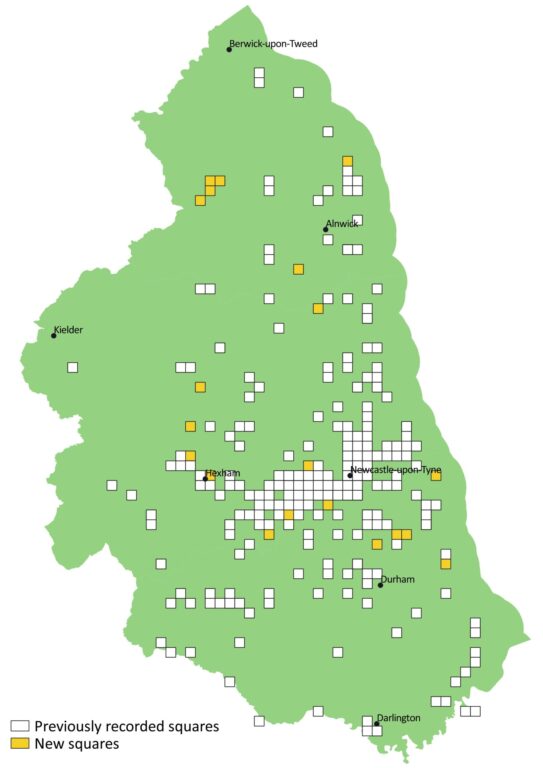Thank you again to everyone who has taken part in the North East Bee Hunt. Your records are bringing to light new information about the North East’s bees and have now taken us to an outstanding 1750 records!
Beginner or expert, everyone can take part in the North East Bee Hunt. If you’re unsure about how to submit your records, a guide to using iRecord can be found here. If you are unsure which bee you have seen, please get in touch with us on social media or by email at nhsn@ncl.ac.uk – we’ll try our best to help.
Below, Charlotte Rankin highlights your records and observations over the past fortnight
As we approach the end of July, a fantastic 1,750 records have been submitted to The North East Hunt. Over 160 recorders across the region have submitted records of 36 confirmed species, with Tree Bumblebee (Bombus hypnorum), Red-tailed Bumblebee (Bombus lapidarius), Common Carder (Bombus pascuorum) and Early Bumblebee (Bombus pratorum) representing the species most frequently encountered so far. Included in these species are those less frequently encountered in the region and with very few known records.
The distribution of records is increasing with each fortnight and your records are building a much better understanding of bee distributions in the region. Going into August, there is still time for bees to be observed and mapped – can gaps be plugged in the west of the region this fortnight? If you have sighted a bumblebee and are unsure on its identification, try this bumblebee crib sheet by the Bumblebee Conservation Trust and the online photo guide by leading bee expert Steven Falk. Please do also get in contact with us via nhsn@ncl.ac.uk or social media, and the NHSN Bee Team will try their best to help.

By collectively putting bees on the region’s map, we can build a greater understanding of where bees are and how they are faring in the region. All records are checked and verified by experts on iRecord and made available to inform monitoring and conservation efforts.
Bees seen this fortnight
A number of bee species have been recorded this past fortnight including three particularly special species in the region. Bilberry Bumblebees (Bombus monticola) have been observed busily foraging in the Cheviot Hills while two new solitary bee species for The North East Bee Hunt have also been sighted along the Tyne: the Wool Carder bee (Anthidium manicatum) and the Gold-tailed Melitta bee (Melitta haemorrhoidalis).
Bilberry Bumblebee
Bilberry – or Mountain – Bumblebees are a locally common species in the region, found in North Northumberland and the North Pennines. As the name suggests, this species is generally associated with higher altitude and moorland areas (monticola meaning ‘mountain-dweller’) with plentiful Bilberry. This species looks very similar to the much more common Red-tailed Bumblebee, but the red tail of Bilberry Bumblebee covers most of the abdomen and both females and males have yellow banding.

Wool Carder bee
One of the largest British solitary bees, Wool Carder bees are robust bees with distinctive yellow spots down the sides of the abdomen. On the wing from June to August, females are unique among British bee species to use woolly hairs of plants as nesting material. Lamb’s-ear (Stachys byzantina) seems to be a firm favourite for gathering nesting material and females nest in hollow stems, dead wood and bee hotels. Males are highly territorial and defend flower patches against other ‘intruders’ by tackling – and sometimes injuring – unwanted visitors. With one record each from Wylam in South Northumberland, Berwick and County Durham for this species in the region, a record from Walwick is particularly exciting.

Gold-tailed Melitta bee
Gold-tailed Melitta bees are very specialist species found in areas with plentiful Harebell. Females collect pollen exclusively from Bellflowers (Campanula spp.) – typically Harebell – and so are often seen with bright purple pollen loads on their hind legs. Their scientific name ‘haemorrhoidalis’ refers to the orange-red tail tip of the females. On colder, overcast days you may be lucky enough to find dozing and sheltering males inside Harebell flowers. On the wing from July to August, females excavate nest burrows in the soil. While there are few records of this species in the region, do keep a lookout where there is plentiful Harebell as there may well be more sites to be discovered.

By Charlotte Rankin, local naturalist